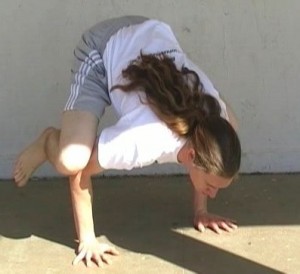Since releasing the Secrets of the Handstand Quick Start video for free on the site last week there has been more traffic here, more people signing up and lots of emails of thanks. Thanks everyone for spreading it around.
Got this report from Dan who purchased the Secrets of the Handstand Quick Start DVD awhile back before I released it. He has been making progress. As it’s quite long I’ll make comments and answer questions as they come up.

The Frogstand - One of the lead-up stunts to the handstand.
hi – i have gotten to a minute or more on the lead-up stunts but have been only practicing the kick-up and toe-touch handstand for 5 minutes twice a week. i am making progress with it, but because i’m practicing so little, i have only done 5-10 seconds as my max handstand with toes off the wall and have only kicked up into handstand successfully once.
With easier moves like the lead-up stunts and handstand you can get by with a minimal amount of practice. Even five minutes twice a week and you’ll eventually get it. Of course, with more time spent practicing you’ll make progress faster. Also for the harder moves like the one handed handstand don’t think you can get by with this little practice.
i promise i will keep working on it and i am not discouraged at all, just lazy and a little busy. but i know i can do it. i also do two sets of ten handstand pushups (going half way down or so) to build up some strength. i’m definitely stronger than when i started.
Though I didn’t include handstand pushups in that DVD they’re obviously a great exercise for building strength. A great complement to the work you’re doing
sometimes i practice on a hard floor and sometimes on the carpet or grass. hard floor seems easier….do you have any comments about pros and cons of using a soft surface?
A hard surface is superior in that you can transfer the force in your wrists and hands to balance best. A soft surface has give making this harder. If you want a real challenge attempt to hand balance in the sand. On the flip side a complete newbie may want to try handstand’s in the grass first, in case they fall.
also my wrists tend to hurt after less than a minute of being in a handstand….they get better after a few minutes, but i do tend to quit because i am afraid of injuring my wrists. i do stretch them for about 10 seconds in two directions before i start practicing. do you have a suggestion of how much discomfort you should practice through and when you should quit for a while? (i’m 36 yrs old and healthy.)
There is a difference in pain of stretching and pain from an injury. Hopefully you won’t come close to the second. Stretching first is important. As you warm them up and get use to the position they should become more flexible. At this point you can keep going. If they start to feel sore, like you’ve done too much, then you should call it a day.
i like the dvd. i like the ideas of lead-ups and toe-touch and kick-up suggestions – i wouldn’t have thought to do any of those on my own, i don’t think. i don’t have any suggestions for improvement in the video other than to say something about keeping your mind quiet when you are up there. as a novice, my thoughts tend to race when i get upside down. “am i doing it right…my arms are getting tired, i’m gonna fall” etc. of course these thoughts hurt your performance. so concentrating on breathing or the body position or something is helpful to prevent your mind from working against you. thanks and hope to hear from you.
Dan
Thanks for the report Dan. I agree with you about the mind. Instead of thinking of all the component parts, which can be tough in the beginning, merely focus on what you’re trying to achieve, staying in the handstand.
Now I’d love to hear your thoughts on the video. Are you seeing success with the lead-up stunts? Hit a road block anywhere? Comment below.
And of course, if you haven’t seen this video yet all you have to do is sign up on the side.
Good Luck and Good Hand Balancing,
Logan Christopher






